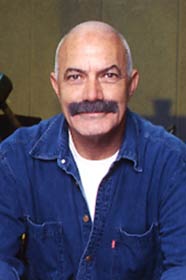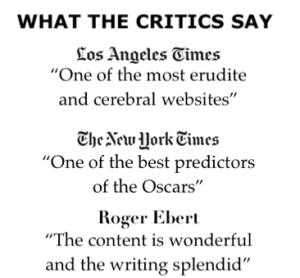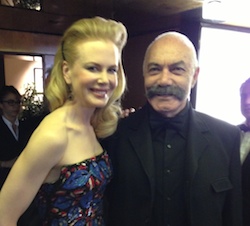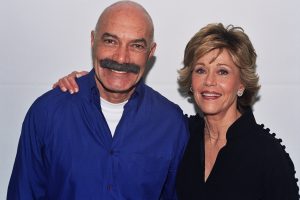It took “Gerry” over a year to make it to theaters, during which Van Sant began production on his next film, the controversial “Elephant.”
He was approached by HBO and actress Diane Keaton (serving as producer) to make a fictional film based on the 1999 Columbine High School massacre. Van Sant chose to shoot the feature in his hometown, casting untrained teen actors for a chronicle about an “ordinary” high-school day underlined by unexpected mayhem and tragedy.
“Elephant,“ the film’s title, derives from a 1989 BBC short feature of the same name, directed by Alan Clarke. The moniker, “there’s elephant in the room,” refers to a collective denial of a grave problem. Dealing with fanatical political violence in Northern Ireland, Clarke’s “Elephant” relies on a minimalist visual style, which has also inspired Van Sant.
Set in the fictional Watt High School in a Portland suburb, the tale chronicles the events surrounding a senseless shooting. Going into the film, Van Sant anticipated controversy, as he told the L.A. Times: “An event like the Columbine school shooting is so grotesque that the taste level of doing a dramatic piece is brought into question, because of the way we think of drama itself. We think of it as entertainment, but I’ve never really thought of it as strictly entertainment.” The tragic incident was still fresh, what with the extensive coverage by the media, which reported the attack in grisly graphic detail. The shooters’ faces then appeared on the cover of “Time” magazine. And, of course, Michael Moore’s 2002 Oscar-winning documentary, “Bowling to Columbine,” includes surveillance footage of the shooting from within the high school.
“Elephant” provoked strong reactions from critics, who either embraced or rejected the director’s decision not to offer any rationale for the characters’ homicidal tendencies. The consensus from the jury of the Cannes Film Festival was unanimous, however, and in a surprise decision, the Grand Jury awarded “Elephant” the top prize, the Palme d’Or, and Van Sant his first Cannes Best Director kudo. The U.S. premiere of “Elephant” was a fundraiser for Outside In, an organization aimed at helping youth living on the streets of Portland.
Van Sant returned to the low-key style of his early independent efforts with this semi-improvised exploration of how violence infiltrates a typical American high school. Eric (Eric Deulen) and Alex (Alex Frost), close friends and students in a middle-class suburb of Portland, look ordinary but they are misfits. They seem confined to the edges of the clique-oriented social strata of the school, but little about their behavior draws attention to itself, at least not during this “typical” day. In their leisure, the boys show fascination with Nazi iconography, enjoy violent video games, explore homoerotic desires, like a quick masturbatory sex in the shower, which is implied but not shown.
A long tracking shot reveals Mr. McFarland (Timothy Bottoms) driving erratically to drop off his son, John (John Robinson), at school. John realizes that his father is drunk, and instructs him to move to the passenger’s seat. We immediately get the idea that the adult world, represented by Mr. McFarland, is not to be trusted. The camera then follows students as they walk back and forth down the hallways, talk to their friends, go indifferently to their classes, which don’t hold any special interest for them.
The film melds long takes, like those taken in “Gerry,” with Harris Savides’ famously fluid camerawork. The individuals are shown in elegant tracking shots that position and dwarf them against the setting. Alex and Eric are being bullied by the school’s jocks. One pupil diverts a teacher and then throws a spitball at Alex during a science class. Later, Alex and Eric order weapons from a website and received their riffles in the mail. They plan an armed ambush of their school by drawing up diagrams. They formulate a precise attack strategy while using graphic charts of the school’s sites, including the lunch room. While Alex is taking a shower, Eric gets in with him. He claims that he has never kissed anyone before, and the two kiss and play (which is seen through the glass door).
The next day, Alex and Eric make their way to school. Upon arrival, they encounter John and tell him to leave, because “heavy shit is about to go down, man.” Bright and alert, John realizes instinctively what is about to happen. He tries to warn others not to enter into the school, but to little effect. No one believes him—after all, it’s yet another uneventful day at school, where nothing much ever happens. The two gunmen then invade the premises. When their initial plan to blow up the school with propane bombs fail, they begin shooting randomly and indiscriminately. Elias (Elia McConnell) photographs them entering the library where they open fire, shooting several innocent students, including Michelle. Realizing that the gunfire is for real, the students begin to panic, while their teachers attempt to evacuate everyone. The two boys separate as they continue their killing spree. Alex enters into the bathroom where Brittany, Jordan and Nicole are necking.
Mr. Luce, cornered in the hallway, begs Eric to lower his weapon and talk to him, but Eric yells, “I ain’t putting shit down!” and fires at him. He does speak to Mr. Luce, however. While doing so, he turns around suddenly to see Benny approaching him. Eric shoots and kills Benny and then turns back to Mr. Luce, warning him not to bully anymore kids like Alex and himself. Eric says he would let Mr. Luce go unharmed, but seconds later, he guns him down coldly. Alex then enters into the cafeteria and strikes a brief conversation with Eric, which ends when Alex shoots his chum in mid-sentence. Alex leaves the cafeteria, showing no emotion, and when he discovers Carrie and Nathan in a freezer, he tauntingly recites “Eeny, meeny, miny, moe,” in order to decide who to kill first.
“Elephant” ends as it begins, with a shot of cloudy blue skies. Clouds in their various colors, formations, and movements are a staple in Van Sant’s work, dating all the way back to “Drugstore Cowboys” and “My Own Private Idaho.”
Made on a small budget of $3 million, “Elephant” was a commercial failure domestically, grossing only $1.3 million at the box office. However, it was far more popular in foreign countries, which accounted to 80 percent of its total global take of $10, thus recouping the expense and even turning some profit for HBO. (In general, Van Sant’s work is more appreciated in Europe than in the U.S.)
As noted, “Elephant” could be described as the first panel of a triptych, which also includes “Last Days” and “Paranoid Park,” all of which were shown in the main competition of the Cannes Film Festival.










